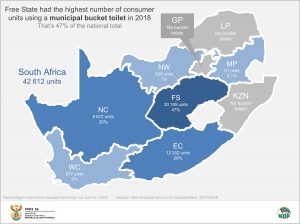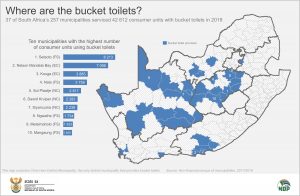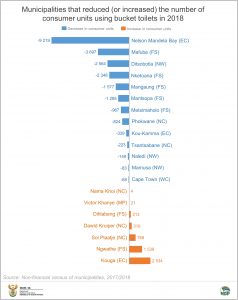Municipal bucket toilet use continues to decline
The number of consumer units using municipal bucket toilets fell from 60 557 in 2017 to 42 612 in 2018. This represents a 29,6% decrease in a single year, according to the latest Non-financial census of municipalities report.
In 2014, the total was 85 718.
The bucket toilets1 mentioned here are those that municipalities provide to communities located within their jurisdictions.2 Municipalities often provide bucket toilets as a temporary measure while more permanent sanitation options are being considered. Various difficulties often delay the process, making it hard to replace bucket toilets once they have been introduced.
Eastern Cape, Free State, North West and Western Cape saw a decline in bucket toilet use in 2018, according to data from South Africa’s 257 municipalities. The number edged up slightly in both Mpumalanga and Northern Cape. Gauteng, KwaZulu-Natal and Limpopo reported zero provision of bucket toilets.
Almost half of all consumer units3 that use a bucket toilet in South Africa are located in Free State. Twelve municipalities in that province provided bucket toilets to a total of 20 185 consumer units in 2018. Setsoto, Nala and Ngwathe were the municipalities that recorded the highest number, servicing bucket toilets for 8 213, 3 759 and 1 734 consumer units respectively.
Eastern Cape had the second highest number of consumer units using a bucket toilet, followed by Northern Cape (click on the map to enlarge).
Municipalities have made a concerted effort to provide communities with better forms of sanitation. These include septic tanks, ventilated improved pit latrines (VIPs) and flush toilets.
Stats SA, in an article on bucket toilets in 20174, made mention of Nelson Mandela Bay’s commitment to eradicate bucket toilets by the end of 2017.5 The data show that Nelson Mandela Bay has not yet managed to eradicate bucket toilets entirely, but it has reduced the number quite significantly. In 2018, the municipality replaced bucket toilets with better forms of sanitation for just over 9 200 consumer units. This represents a 56% decline in bucket toilet use!
In 2017, Nelson Mandela Bay was the municipality with the highest prevalence of bucket toilet use. It now finds itself in second place after Setsoto local municipality.
Together with Nelson Mandela Bay, twelve other municipalities are on the honour role for reducing bucket toilets in 2018. Mafube (Free State), Ditsobotla (North West), Nketoana (Free State), Mangaung (Free State) and Mantsopa (Free State) are notable examples.
Kou-Kamma (Eastern Cape) and Phokwane (Northern Cape) are the two municipalities that stopped providing bucket toilets entirely in 2018. Kou-Kamma, for example, replaced all bucket toilets with VIPs.
Altogether, these thirteen municipalities provided better forms of sanitation to 23 343 consumer units, making a difference to the lives of thousands of families.
Seven municipalities increased the provision of bucket toilets in 2018, by an aggregate of 5 398 consumer units. Most notably, Kouga (Eastern Cape) and Ngwathe (Free State).
Despite the country’s continued success in reducing the number of bucket toilets, many families continue to live without more adequate forms of sanitation. Stats SA will continue to monitor bucket toilet provision, reporting annually in its Non-financial census of municipalities report.
For more information, download the Non-financial census of municipalities, 2017/2018 report and unit data in Excel here.
1 A bucket toilet is a basic form of a dry toilet whereby a bucket (pail) is used to collect excreta. Usually, faeces and urine are collected together in the same bucket.
2 The figures from the Non-financial census of municipalities report cannot be compared with data on bucket toilets from Stats SA household surveys, such as the population census, Community Survey, and the General Household Survey. This is because the Non-financial census of municipalities survey measures the supply side of service provision in South Africa, and reports on only those buckets provided and collected by municipalities.
3 A consumer unit is an entity to which the service is (or would be) delivered, and which receives one bill if the service is billed, alternatively known as a delivery point. This concept is often referred to as a household by municipalities, but this is not strictly correct, as households and consumer units do not coincide one to one, particularly in blocks of flats, on stands where there are multiple households in the same dwelling, and in the case of public taps.
4 Stats SA, Municipalities: where are the bucket toilets? [19 June 2017] (read here).
5 MyPE, @AtholT Commits to eradicating Bucket Toilets [22 September 2016] (read here).
Similar articles are available on the Stats SA website and can be accessed here.
For a monthly overview of economic indicators and infographics, catch the latest edition of the Stats Biz newsletter here.




